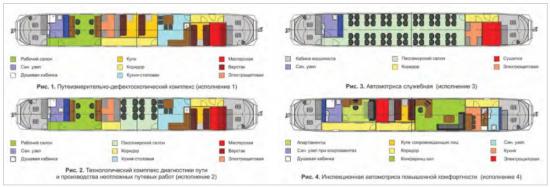|
In
2009, TVEMA developed and manufactured the first vehicle of the MFV project. This
multifunctional vehicle provides Quality and efficiency in the servicing of
track and infrastructure facilities and hence ensures a high safety level of
railway traffic. The railcar is currently successfully operated in several
railways of OAO RZD (Russian Railways).
The innovative, state-of-the-art Technologies from domestic and
external manufacturers were applied in the design and development of the MFV
railcar. The railcar is manufactured using special materials and coatings,
ensuring operational comfort for work crews, while not compromising operating
economy.
The digital control panel in the driver cab allows for the elimination
of copper conductors with aging insulation. Innovative software and integration
with traffic control systems dramatically improves operational safety. An
instrument compartment and workshops are provided for the work group, and
comfortable lounges, a canteen and a shower compartment equipped with suitable proper
furniture and appliances contribute to the crew’s comfortable leisure. The
railcar is equipped with a micro-climate control system and automated
fire-fighting system respectively for the engine and the premises. The railcar’s
systems and equipment, including the MTU diesel generator, cause very low noise
and vibration in any part of the railcar at travel speeds up to 120 km/h. An
MTU Power Pack serves for the electric traction motors of the railcar and for the
power supply of all power consumers on board. To ensure the most efficient
employment of vehicles in the MFV project, TVEMA offers several versions of
this railcar.
Diagnostic railcar
One of the primary functions of MFV railcars is to serve as a platform
for the installation of any combination of various diagnostic systems. These
are: systems for track geometry measurement, systems for ultrasonic and
eddy-current testing, 3D laser scanning systems, GPR, etc. Various options for
the railcar’s layout are offered to facilitate the selection of the proper railcar configuration for each
particular task.
System of secondary diagnostics and urgent
repair
The version for secondary diagnostics and urgent repair is ready to
handle the tasks of reliable confirmation and repair of infrastructure facility
malfunctions, which have been detected. To transport the mobile repair crews
the system has a passenger room with 15 seats. To support crew operations, it
has an equipped workshop compartment. To support crew operations, the system
has a set of the necessary manual equipment for reliable secondary diagnostics.
Inspection railcar
The inspection railcar is equipped with video inspection and
monitoring systems, as well as with other equipment required for inspections,
which are conducted by officials of the railway companies. The railcar ensures
the most comfortable conditions for operations.
Geological railcar
Often diagnostic techniques are not enough. Therefore, the
instrumental technique is offered – the drilling rig. The vehicle for
comprehensive probing and diagnostics of the ballast bed and roadbed of the track
by geologic engineers is equipped with a telescopic crane, which is mounted on
the cargo platform, with a drilling rig and a set of drilling tools.
Passenger/cargo railcar
Passenger/cargo rolling stock is intended for comfortable
transportation to the work site of large track repair crews numbering up to 50
persons. The railcar is equipped with household utilities for catering and
hygienic needs.
Further equipment is: a cargo platform where a telescopic crane is
installed, detachable implements and tools for hoisting and track management purposes.

|
Parameter
|
Parameter
Value
|
|
Track gauge, mm
|
1520
|
|
Number of axles
|
4 (two double-axle bogies)
|
|
Minimum curve radius, m
|
160
|
|
Compliance with the clearance profile under
GOST for transport
|
1-T
|
|
Overall
dimensions, mm:
•
coupled length
•
width
•
height (from rail head level)
|
23500±15
3100±15
4850±10
|
|
Power of vehicle generators:
• supplied by main generator, kW
• supplied by additional generator, kW
|
≤150
≤30
|
|
Error in track coordinate, %
|
≤1
|
|
Deviation of track gauge standard (1520 mm)
[gauge], mm
|
-10...+40
|
|
Relative position of both rail threads by
height [level], mm
|
±160
|
|
Rail thread sag, mm
|
±50
|
|
Camber of rail thread in the horizontal plane
with respect to straight chorde of 21.5 m length measured at 4.1 m from
chorde end [alignment], mm
|
±225
|
Detected defects:
According
to NDT-TsP-1-93: 10.1-2, 11.1-2,
17.1-2, 20.1-2, 21.1-2, 24.1-2, 25.1-2, 26.3, 27.1-2, 30G.1-2, 30.В.1-2, 38.1, 52.1-2,
53.1-2, 55.1-2; 56.3, 66.3, 69.1-2, 70.1-2, 74.1-2, 79.1-2, DR.21.2, DO.20.2 ,
DSN.20.2, DO.60.2 & DSN.60.2, DUN.21.2, DU.22.2;
According
to UIC Code 712 R: UIC111/211,
UIC411.1/421/431, UIC471/481, UIC112/212, UIC113/213, UIC133/233, UIC132.1/232.1,
UIC132.2/232.2, UIC135/235/236, UIC154/254, UIC100/200, UIC301/302, UIC412/422,
UIC127/237, UIC125/225
|


